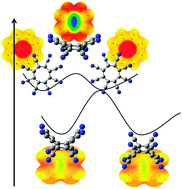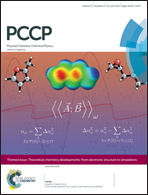Influence of fluoro and cyano substituents in the aromatic and antiaromatic characteristics of cyclooctatetraene†‡
Abstract
An exhaustive and systematic study of the structural and electronic properties of cyclooctatetraene (COT) upon substitution of hydrogen atoms by fluoro and cyano groups has been carried out in order to analyse the influence of both substituents on the aromaticity. We found that C–C distances decrease with fluoro substitution while in cyano derivatives the opposite happens. All the compounds retain their original structural type, with the exception of the cyano derivatives; thus, compounds 25CN6T, 27CN6T and 30CN8T show boat-like structure, whereas compounds 20CN5T, 26CN6T, and 29CN7T present twisted structures. Regarding the relative energies of those compounds with the same number of substitutions, it was found that compounds where the X groups were more separated among them were the most stable ones. Inversion barriers (ΔETS) were found to increase with the number of substitutions; in the case of fluoro derivatives these barriers have a two-fold, increase compared to the parent compound while in the cyano ones a three-fold increase was observed. The aromatic character based on the NICS values, was found to increase in the ground singlet states and in the transition states of both fluoro and cyano derivatives. For triplet states, a decrease of the aromatic behaviour was found upon substitution. NICS profiles and 3D NICS isosurfaces confirm such findings. Finally, HOMA indexes corroborate the aromatic changes described by the NICS values, although, no good correlations between both quantities were found.



 Please wait while we load your content...
Please wait while we load your content...